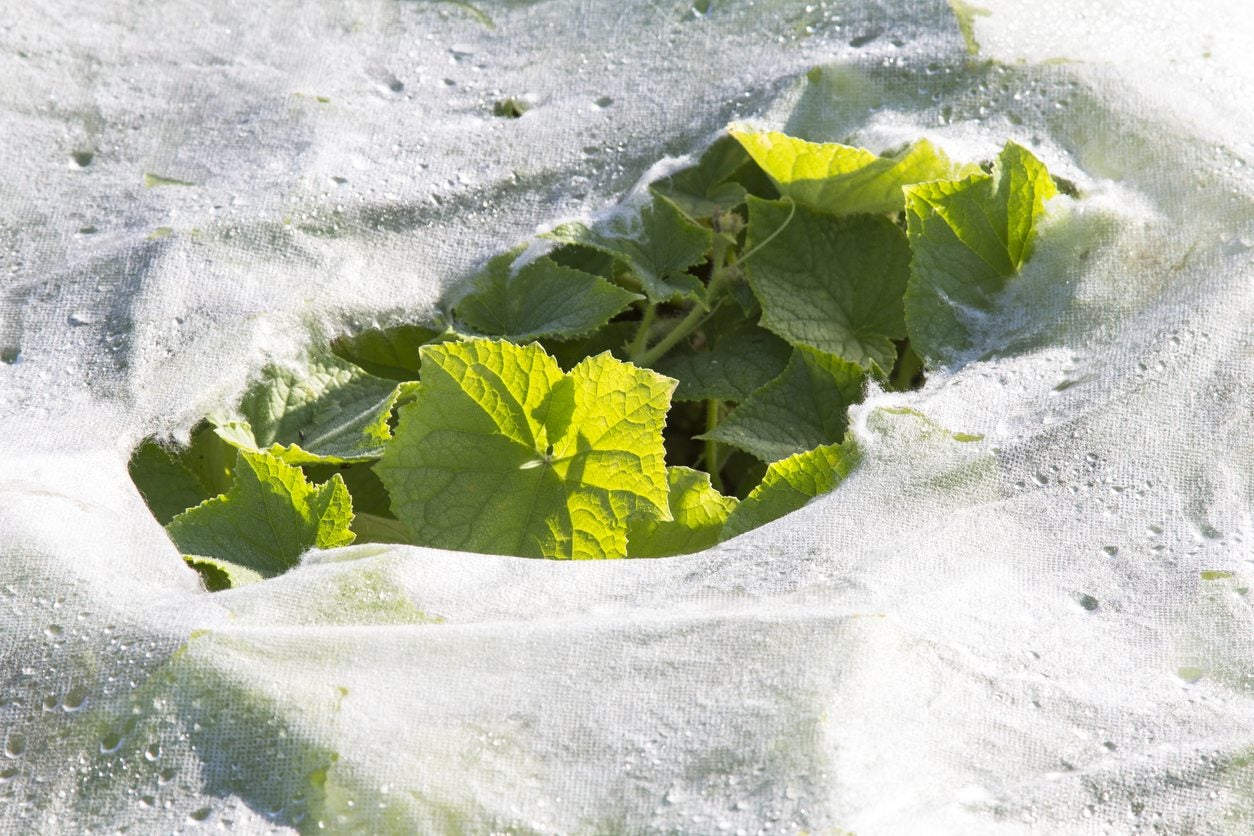Cucumber Plant Damage: Tips On Protecting Cucumber Plants In The Garden

Healthy cucumber plants will provide the gardener with a bountiful harvest of the delicious, crisp fruit, sometimes too bountiful. Unfortunately, there are plenty of insect pests that might get to the cucumbers before you do or transmit diseases, rendering plants unable to produce. It isn’t just insects that cause cucumber plant damage, however. Sudden cold snaps can kill the plants as well, so protecting cucumber plants is of paramount importance. Read on to find out how to protect cucumber plants and about keeping cucumbers protected from predatory insects.
Protecting Cucumbers from Cold
Cucumbers (Cucumis sativus) are tender annuals that thrive in warm temperatures of between 65 and 75 degrees F. (18-23 C.). Even prolonged exposure to temperatures below 55 degrees F. (13 C.) can cause decay, pitting, and water-soaked areas on fruit. Sudden cold snaps can cause cucumber plant damage on leaves, stems, and fruit or even kill the plants. Frost damage is seen as shriveled, dark brown to black foliage. While global warming has been increasing temperatures around the world, it also makes for unpredictable weather such as sudden cold snaps. So, it’s important to have a plan and take steps to protect cucumber plants and other warm season annuals from the risk of sudden frost, thereby, avoiding damage to cucumbers. First off, grow cucumbers in sheltered areas of the garden. Avoid open, exposed sites or low spots in the garden where cold air will collect. Grow the fruit along fences, boulders, or shrubs to provide them with some protection from the cold. If a sudden cold snap is forecast, cover the cucumbers. The plants can be covered with whatever you have on hand-- old bed sheets, plastic, newspaper, or other light material. Push some sturdy sticks into the ground around the plants to support the covering and weigh down the corners with stones. You can also use wire (extra wire coat hangers will work) to form a curved arch upon which to lay the covering. Tie the ends of the covering to sticks pushed into the ground. Remember to open the row cover daily to allow condensation to evaporate. Close them again by midafternoon to trap heat overnight. Temperatures inside a row cover will be from 6 to 20 degrees warmer than outside and soil temps 4 to 8 degrees warmer down to 3 inches (8 cm.) deep. In lieu of covering the cucumbers with row covers, there are other methods for keeping cucumbers protected from cold. Use a shingle or other broad board stuck into the ground on the windward side of each plant to protect them from cold winds. Place a plastic milk container, bottom cut out, over each plant; large aluminum cans will also work.
How to Protect Cucumber Plants from Pests
There are many insect pests that are more than happy to sample your cucumbers. Some of them even introduce disease into the cucumber patch. Cucumber beetles are guilty of introducing bacterial wilt. They carry the disease in their bodies, and it overwinters with them as they hibernate in vegetation left in the garden. Avoiding damage to cucumbers due to cucumber beetles and the resulting bacterial wilt requires a two-part approach. Be sure to clean up detritus, including weeds, in the garden at the end of the growing season to avoid leaving any hidey-holes for the beetles to hibernate and overwinter in. Then in the spring after planting, cover the cukes with a lightweight floating row cover. Remember to remove the cover after the plants begin to flower so they can be pollinated. Aphids will also get at cucumbers; actually, aphids seem to get at everything. They reproduce rapidly and colonies of them are difficult to control. At the first sign of aphids, treat the plant with insecticidal soap. Other ideas to combat aphids are planting in an aluminum foil-covered bed and filling yellow pans with water, which will entice the aphids and drown them. Encourage beneficial insects that prey on aphids by planting flowers nearby that attract them. Aphids and leafhoppers also introduce mosaic virus into the garden. Leafhoppers suck the juice from the leaves and stems of cucumbers. Here again is a situation where the use of row covers can mitigate infestation. Also, spray with insecticidal soap. Leaf miner larvae tunnel through leaves. Use floating row covers and destroy any infected leaves. Cutworms are another hazard to cucumbers. They chew on stems, roots, and leaves. Cutworms live under the surface of the soil so protect the plants by placing 3 inches (8 cm.) of paper collared around the stem of the plant or use saved canned food containers with the top and bottom cut out. Also, keep the garden free from weeds and sprinkle wood ash around the base of the plants. Spider mites also love cucumbers. Spray them with water or insecticidal soap or rotenone. Encourage beneficial predators, such as ladybugs and lacewings. Whiteflies can also be found congregating on the underside of the cucumber leaves. Again, beneficial insects should be encouraged. Also, remove infested leaves. Other types of insects enjoy munching on cucumbers. Where they can be seen, handpick them and dump them in a bucket of soapy water. Snails and slugs will snack on cucumbers, especially young plants. Handpick them as above or if that’s too disgusting for you, bait some traps. Pour some beer into a low bowl and place a few around the plants. The slugs will be enticed by the beer and crawl in and drown. Diatomaceous earth sprinkled around the plants will thwart these pests as well.
Sign up for the Gardening Know How newsletter today and receive a free copy of our e-book "How to Grow Delicious Tomatoes".

Amy Grant has been gardening for 30 years and writing for 15. A professional chef and caterer, Amy's area of expertise is culinary gardening.
